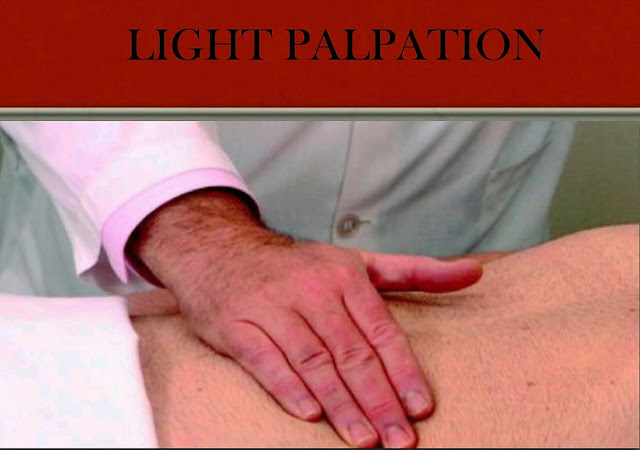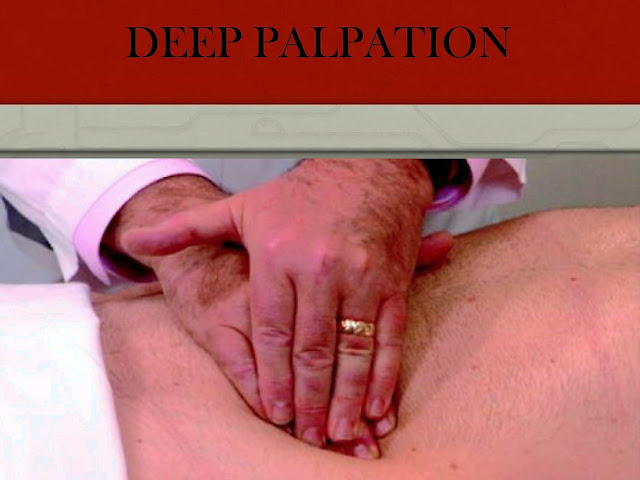Physical Examination of the Abdomen
Physical Examination of the Abdomen
Examiner & Patient Position
| Examiner | Patient |
| On the right side of the Patient | 1. Lying on Flat bed. 2. Arms on the sides 3. Abdomen exposed 4. Legs extended during inspection 5. Legs bent |
Quadrants of Abdomen
- Right upper quadrant
- Left upper quadrant
- Right lower quadrant
- Left lower quadrant

Regions of Abdomen
- Epigastric
- Umbilical
- Suprapubic
- Right Hypochondrium
- Right lumbar
- Right Inguinal
- Left Hypochondrium
- Left Lumbar
- Left Inguinal

Steps of Examination of Abdomen
- Inspection
- Palpation
- Percussion
- Auscultation
Inspection
- General appearance
- Writhing in pain (Renal or biliary colic)
- Lying still in bed (Peritonitis)
- Pale and sweating (Shock from pancreatitis or gastric perforation)
- Respiratory rate
- Inspect the abdomen
- Contour
- Striae
- Ecchymosis
- Grey Turners’ sign
- Flank discoloration
- Massive ecchymosis secondary to hemorrhagic pancreatitis
- Cullen’s sign
- Bluish discoloration of the umbilicus secondary to hemoperitoneum of any cause
- Surgical scars
- Inspect for Hernias- ask patient to cough
- Inspect the superficial veins
- Evaluate the direction of drainage
- Place tip of your index fingers on a vein that is oriented cephalad-caudad
- Compress and slide index fingers apart for about 7-10 cm
- Remove finger and observe the direction of flow
- Vena caval obstruction: veins drains toward the head
- Portal hypertension: dilated veins radiate from the umbilicus
| Other causes of Turner or Cullen’s Sign: 1. Ruptured ectopic pregnancy 2. Severe trauma 3. Ruptured abdominal aortic aneurysm 4. Coagulopathy 5. Any condition with bleeding into abdomen |
Palpation
Light Palpation

Deep Palpation

Begin in an area farthest away from the pain Use the flat part of the hand or pads of the finger Lift hand from area to area.
Percussion
- Liver size
- Shifting dullness (Ascites)
- Evaluate all 4 quadrants
- Percussion of the liver
- Start on the Right midclavicular line in the mid chest
- Percuss downwards
- Chest: resonant
- Liver: dull
- Colon: tympanic
- Percussion of the spleen
- Spleen hidden within the rib cage against the Traube’s space
- Rule out ascites
- Examine for “shifting dullness”
- Test for “fluid wave”
| Traube’s space defined by: Superiorly- 6th rib Laterally- anterior axillary line Inferiorly- costal margin Dullness in Traube’s space is observed in splenic enlargement |
Auscultation
- Bruits
- Friction rubs (Vascular disease)
- Loss of bowel sounds (Ileus)
- High-pitched, hyperactive sounds (Intestinal obstruction)
- Motion of air and liquid in the GIT
- Use diaphragm of stethoscope over mid abdomen
- Normal bowel sounds occur every 5-10 mins and have high-pitched sound
- Absence of bowel sounds (Ileus )
- Rushes of low-pitched rumbling sounds (Hyperperistalsis) “Succussion splash” (Observed in obstruction)
- Listen for bruits
- Evaluate each quadrant May occur in stenosis of the renal artery or abdominal aorta
- Listen for friction rubs
- Right and upper left quadrant
- Hepatic and splenic disorder
| Thank you Reader |
| Your Like Motivate Us To Post New And Unique Articles So Don’t Forget To Like, Comment and Share This Post. LIKE US On Our Facebook Page To Get Latest Updates. |
| Copyright © by edumedweb.com All rights reserved. No part of this post/article may be reproduced, distributed, or transmitted in any form or by any means, including copying, photography, Screenshot or other electronic or mechanical methods, without the prior written permission of the Admin. Otherwise strict legal action taken against that person. For permission requests, write to the Admin |
